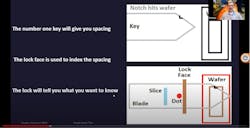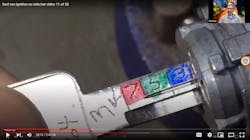Recently, Thomas Thill was asked to make keys for a late-model Isuzu NPR truck.
“I got no tool that will decode the lock,” Thill recalled, adding that the truck had an odd keyway, before taking a pause. “Yeah I do. I got a Framon code machine and I got key blanks — not a problem.”
That’s because Thill, who operates out of Transponder City in the Chicago suburb of Bridgeview, Illinois, knew how to make push keys that would help him to decode the ignition without taking it apart.
What are push keys? Push keys are Thill’s invention that he uses to decode wafer cylinders and cut keys for automotive locks and the topic of the latest meeting of Locksmiths United, led by Wayne Winton.
The Hit Factory
Simply put, a push key is a marked key blank that has a tiny notch cut into the tip at various depths depending on the keyway. When inserted into a cylinder that has wafer tumblers, the notch makes contact with a wafer or not depending on the wafer’s depth.
Depending on the location of the notch, those hits will provide the depth of the wafer and, thus, the depth of the corresponding key cut.
In addition to the notch, the push key also has a series of markings and numbers along the side that allow you to identify the wafer position in the cylinder when you have a hit as you insert the key. Different keyways require different keys, and some keyways require a set of push keys to decode a lock.
Thill demonstrated how the system works by using a set of five push keys on a seven-cut ignition lock on a Ford van, where the first position is empty. His push keys have color-coded markings for positions 2, 4, 6 and 8 on one side and 3, 5 and 7 on the other.
Starting with the No. 1 depth push key, Thill got hits on all seven positions. After jotting down marks on his key grid, Thill moved to the No. 2 key, noting hits on positions 2 through 6 and then 8, before proceeding to No. 3 and so on until he had identified the code of X5544312 for that particular ignition. By putting the odd-number locations on one side and even numbers on the other, Thill then cut a key that turned the ignition.
Although he began with the No. 1 key for presentation purposes, Thill suggested starting with the push key for the deepest cut first. Doing it this way helps to speed the process. A No. 1 key when used first could mean the wafer could be anything from a 1 to a 5, because the shallowest cut key will hit every wafer.
“If not, something is going on with the lock,” he said, meaning a problem with that wafer.
However, getting a hit on a No. 5 key automatically means a depth of 5, because wafers that are taller won’t hit on a 5. Getting a hit on a No. 4 key means the wafer is either a 4 or a 5, but, because you already used the 5 key, you know that any hits not already marked are a 4, because they didn’t register a hit with the 5 key. The progression follows logically from there.
Push keys work on single- and double-sided keyways and on sidewinder keys as well — you have to have a left track and a right track push key to decode certain ignitions. They work only on wafer tumbler cylinders, however.
Making the Push
Where the Framon code machine comes into play is in the making of push keys. Thill said any key machine that allows for the use of a slotter, typical in the making of keys for safe-deposit boxes, might work, but he prefers the Framon #2 because locksmiths can make precision adjustments to the x and y axis of the key vise.
For example, he imagined a keyway where the 5 depth was .220 inches. “The push key has to be deeper than .220 to contact the deepest cut.” For this keyway, he makes the notch for the No. 5 push key at .200 to .210. “Now, you got a .010 ledge that will make contact with the wafer in there. You can make those adjustments accordingly with the other depths.”
Standard locksmithing knowledge comes into play here, too. For the most part, a No. 1 cut is near the top of the key blade and a No. 5 is near the middle, and a certain amount of depth is necessary to keep the key blade from breaking.
As far as sussing out the wafer positions, that comes from “feel” when you insert a key blank into the cylinder. When the notch makes contact with the tumbler, Thill marks the spot on the key blade that’s just outside the lock face with a different color. He does this each time there’s contact, remembering to flip the key to note odd and even locations as necessary. He also marks the order of the colors on the key head as a reminder.
“If they’re all the same color, it’s very confusing,” Thill said. “If you put the key in and it stops on a green, stops on a yellow, stops on a red, you’re going to remember that.”
So, getting back to the Isuzu truck that had the “weird” keyway, Thill used Framon Genericode to look up the code series and discovered that the keyway had four depths with standard numbering and that he had to have at least .100 inches in the middle of the blade to keep it from breaking.
“I’m good at guessing what the increments are supposed to be,” Thill said. “Within 10, 15 minutes, I had four push keys made. I got to the truck; I decoded the ignition; I put it in the code program and came up with one possibility.”
Thill will teach a class on push keys at the ALOA convention in July and added that he’s discussing with Framon on the possibility of that company marketing push keys. Stay tuned. Go here for a video of the presentation.
Locksmiths United
Locksmiths United is a monthly Zoom presentation to discuss locksmithing and provide information to others in the industry. The meeting is scheduled for 7 p.m. ET, the first Monday of each month. Because the first Monday in July is the Fourth, the next meeting is scheduled for Tuesday, July 5, 2022. All locksmiths are invited. Contact Winton via Locksmith Nation’s group page on Facebook for the Zoom link.
About the Author
Will Christensen
Senior Editor
Will Christensen is senior editor at Locksmith Ledger International. He has been an editor and reporter at magazines and newspapers for more than 30 years.


